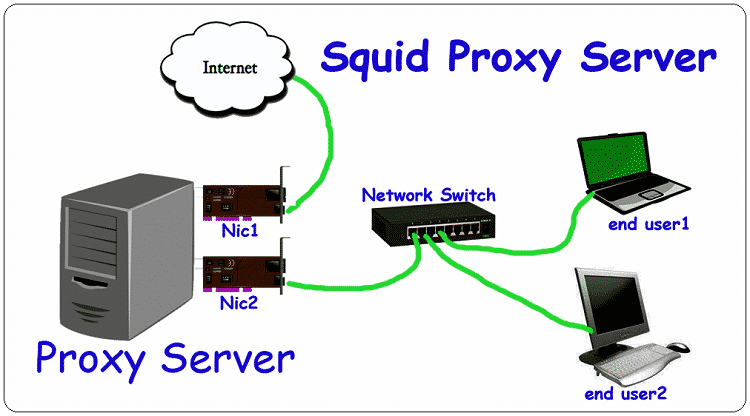Squid is a popular Unix-based proxy caching server. It is widely used to improve the speed of the web server by caching frequently requested web pages as well as media files just like Ninjas Proxy. The response time improves significantly, and the bandwidth congestion decreases massively. It is mostly used for HTTP and FTP. However, it is compatible with other protocols such as HTTPS, SSL, Dopher and likewise. But it does not support SOCKS protocol. In real life, the Squid proxy server is installed on a separate server other than the web server. The primary working of the Squid is through tracking the object use over the network it is connected to. The following is a complete illustration of how Squid proxy server works and how it is beneficiary to boost up web server performance.
The Working Of Squid Proxy Server –
General Concept – In general, a client or user requests an internet object from a web server. Instead of the request going to the web server directly, it goes to the caching proxy server. If the internet object, which can be a web page, document, or any other form of response of a query, is present on the proxy server, it is delivered instantly. The time taken is minimized significantly when server directly from the proxy server. However, if the requested object is not available, the proxy server requests the web server to deliver the content to the client. The efficiency of the proxy server is determined whether it is able to recognize the repeated requests and keep the corresponding objects in it or not.
Squid Proxy Server – Squid needs to be installed on the web server or on a separate server. It acts as an intermediary with the primary job of passing on the client’s request to the server. However, in the process, it saves the copy of the requested object such that if the same client or other clients request for the same object in the near future, it can respond to the request directly. Therefore, the time duration from Squid proxy server passing on the request to the web server and the web server responding back with the internet object back to the proxy server becomes nil. Therefore, the response time becomes fast.
Similarly, due to the request not passing on to the web server, the bandwidth stays free both from sending and receiving. Therefore, the bandwidth can be better utilized for requests that cannot be served by the proxy server. This is significant because there are thousands and thousands of requests to serve every second. If the proxy server can serve even 10% to 20% which are always the common requests, the performance of the web server will get a boost like never before. As a matter of fact, ISPs are using Squid proxy servers for decades to improve the download speed and reduce latency. It is more significant now as people are streaming videos and such heavy media files. It is mostly used for content delivery networks and media companies.
More About Squid Proxy Server –
The best part of Squid is that it is available for free and as an open-source software. Even though it is designed to run on Unix-based systems, it is capable of running on Windows machines and Mac machines as well. Apart from ISPs, it is used in LANs with shared internet connections. It is even more effective in that case. Besides, Squid can be set up explicitly or as a transparent caching mechanism where all requests are cached. But that is not all as Squid is increasingly more used as a reverse proxy. The reverse proxy has a distinct advantage of serving an unlimited number of clients with a limited number of web servers.
In fact, a single Squid server can be used both as a normal proxy as well as a reverse proxy server. A classic example can be a company hosting its website from a web server with Squid proxy server as a reverse proxy server. The same Squid server can also act as a normal web cache server taking HTTP requests from employees within the company. Therefore, the web access speed gets accelerated, and the bandwidth demand reduces.
There are a few issues with Squid proxy servers available which the developers are working on. The issues are not major, however, their solution can improve performance significantly. Some of the new features that are expected in the new version are the automatic load balancing truly becoming automatic from the current semi-automatic state, multicasting cache to cache communications, better recognition of URLs, better selection of parents and routing and much more.
Lastly, the major feature of Squid that most people are not aware of is the media range limitation. Instead of requesting the web server to send the entire file or object, Squid server requests the web server to send the partial parts of the file as per the user’s request. For example, if a person plays a video from the middle, there is no need for loading the first half of the video.

